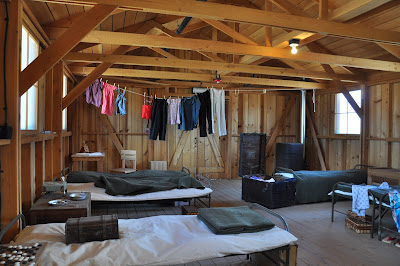Today marked our third visit to Manzanar National Historic Site. The first time we came to Manzanar was in April 2008, during the annual pilgrimage of former incarcerees.
 |
| 2008 |
 |
| 2009 |
Each time we've come here, I've been moved to tears thinking of the horrible injustice of the Japanese incarceration and remembering the racial prejudice I also have experienced. But today's visit was especially meaningful because we were able to bring R's parents with us.
 |
| 2015 |
In 1942 when President Roosevelt signed Executive Order 9066, which authorized the incarceration of American citizens of Japanese ancestry and resident aliens from Japan living on the West Coast, my mother-in-law was only nine years old. She and her family were taken from their home in Norwalk, CA and temporarily housed at the Santa Anita Racetrack before finally being sent to the incarceration camp in Rohwer, AR.
Sadly, like many Japanese-Americans of that generation, my mother-in-law's family did not talk much about their experiences "at camp," so those memories were never reinforced through storytelling and are hard for her to recall now. Even though Rohwer was not Manzanar, we hoped that seeing some of the exhibits today might bring some of those memories back.
The exhibits in the visitor center are very well done! This is a model of Manzanar during the war. By September 1942, the population was more than 10,000 people. The grassy area in the lower part of the picture contained the administrative buildings. The large building by itself on the middle right is the auditorium, which now houses the visitor center. Each block consisted of 14 barracks, men's/women's latrines and showers, laundry room, and mess hall.
Each barrack was divided into four rooms. Eight people were housed per 20 x 25 ft room. R's mom's family had 7 people, so they took up most of the allotted space - we're not sure whether or not they had to share with an eighth person.
Block 14 had a basketball court. The mess hall is in the distance. In between are the slabs with signs marking where the men's latrine, women's latrine, and laundry room stood.
While my mother-in-law's memories didn't come rushing back, she did recall a few details. And she emphatically stated that the barracks and mess hall weren't as nice as the ones re-created here. But the best part about this visit to Manzanar came from the conversation we had with the park ranger. She was able to look up my mother-in-law's family in the government archives and print out a scan of the actual record detailing when they were incarcerated, where they stayed in the camp, and when/where they departed to. R even learned that his grandfather left Rohwer for Cincinnati first, about 10 months before the rest of the family would eventually join him in Chicago.
How important it is to learn from our history and never forget...
*Updated 5/28/2022 to reflect the usage of "incarceration" as the appropriate terminology in place of "internment."










No comments:
Post a Comment